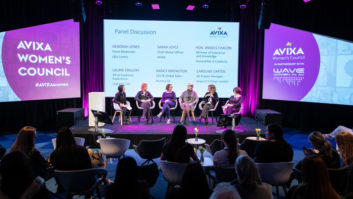 How did you first get involved in the AV marketplace?
How did you first get involved in the AV marketplace?
I’ve had a love of AV and in audio in particular from a young age that started when I assisted my Dad with amateur recordings of local performances in the DFW area. I helped him set up the microphone arrays and monitor the recording levels on his DAT recorder. He was also an audiophile and so heavily influenced me towards high end components early on. This translated into a few home theatre install projects of my own over the years along with being tech support and buyer consultant for my extended family. Career wise I was always involved in the industry as a researcher though, studying the way in which technology impacts our lives and the opportunities this creates. This goes back to my first jobs out of college doing custom research in the IT/VAR space, then into my role as Director of Industry Analysis at the Consumer Technology Association, and finally here at AVIXA as Sr. Director of Market Intelligence (with a few other stops along the path).
What would you say are the most significant changes / developments in the industry during your time?
I’d have to go with the progressive digitisation of content, whether video or audio, to where we can carry whole libraries with us and stream it out all across the world. To our industry this means AV over IP, but it’s really about packetising or compressing at its core. This is huge since content can follow us in so many ways now, creating the opportunity for personalisation of experiences as well as time and place independence. There is some loss to this, since we seem to carry less about the quality of the content and more about the portability, but the gains are substantial. This includes the story of record, to tape, to CD, to DVD, to MP3, and now streaming with similar on the video side. Just an amazing progression.
What personal, professional achievements are you most proud of?
I am the most fond of those moments in which some research we’ve done and shared out with the market sparks some idea or creative approach to a business problem. This is what it’s all about for me – a process of learning and discovery that yields something new. It is a tremendous motivation for me in the research work we do and is why I love the whole process from formulation of idea, to data collection and analysis, and then sharing through presentation and discussion. I also love seeing others I’ve mentored on that discovery process grow and contribute in the same way.
Do you have a philosophy you live by professionally? And if so, how has it helped your career and those you have worked with?
Follow your curiosity and keep asking why. Data, as a product of research, is an inanimate object and resource, but it has a story to tell. Only by being curious and seeking to understand its nuances, going beyond the number and continually asking questions of it, can we reveal the insights it has. This keeps me going and what enables me to be impactful in those times I am able to be.
Pre-Covid, what would you say were the biggest areas of technological or operational challenge to AV?
Commonality of language. In order for the connected world to exist and to realise the benefits of the streaming I talked about above, the systems we have need to speak a common digital language. Unfortunately, there is a huge economic incentive to being the creator and manager of that language and the connective process. This means we end up with walled gardens that don’t allow us to realise the full potential of connectivity, even if they do fulfil goals of security and reliability to some extent. It’s a challenge we will continue to work through but one that faces so many areas of the business, particularly in AV. Of course, then again, this is why we have translators for spoken language so perhaps that becomes a solution opportunity here.
What needs to change in the industry?
A broader realisation that the value has moved well beyond the hardware itself. This exists in some places and is how some think, but a more complete realisation of this will generate tremendously more opportunity for our market. Put another way, thinking that its just about selling and installing hardware misses all of the opportunity that can be had from the bigger picture of how the hardware is used, by whom, and with what content. Each of those questions has a value component behind it so that the solution becomes greater than the sum of its parts. Easy to say in a way, and hard to realise when client X says ‘just put that display there’ but it’s a challenge to always ask why and for what to identify the true opportunities out there.
In your opinion, what will be the biggest drivers of change in AV in the next 5 years?
The experiment that has become the post-pandemic period. Our normal work and life practices have become massively disrupted. We are now figuring out what we liked and didn’t like about a fully remote lifestyle. This will shape a lot of ideas for new ways of engaging, with products and solutions along the way. There is tremendous upside potential to this from my perspective, an X-factor that is difficult to build into a forecast model. But I am sure, the next 5 years will spawn things we would never have imagined would be possible even 5 years earlier.
Finally, what would your message be to those starting out their AV careers?
Find a mentor! I am a big fan of the mentor/mentee relationship as a way of learning and growing with guidance. The key is of course finding the right one with the experience that is relevant to your own path and who can truly lead by example. So choose wisely! Associations, like AVIXA, are a great way to meet potential mentors, but they also often show up in unexpected places and at the times we most need them so stay alert!







